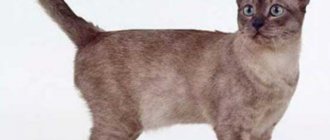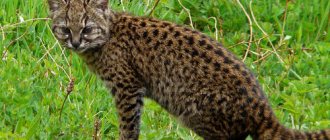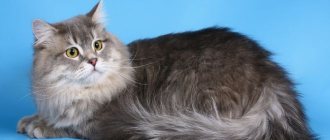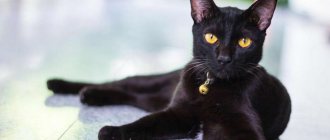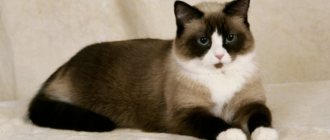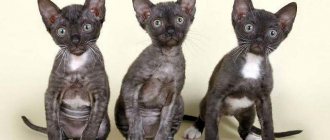History of the origin of the Asian cat
British specialists managed to obtain the breed in the beginning. 80s XX century. The crossing involved cats of three breeds at once - Burmese, Abyssinians and Persians. The matings were carried out in a certain sequence, but the result really exceeded all expectations - the resulting animal had the structure of a Burmese, with the disposition of an Abyssinian, and a combination of the gloss and modesty of an aristocratic Persian. In addition to the best features of the three breeds, the Asian tabby cat took from all of them a variety of colors, as a result of which several new species appeared in one group: tabby, Burmilla, Asian even-colored, Tiffany and smoky.
The breed was recognized by serious felinological organizations of the world, including WCF, 10 years after its appearance - in the 90s. Initially, the number of wool colors did not exceed three - silver, deep brown and plain. But subsequently the breeders managed to significantly “expand” the range.
Diseases
Prevention of deworming - from 1-2 times a year to 1 time every 4 months (depending on the situation). If a cat eats meat, i.e. the risk of infection is high - worms should be removed once a quarter. This is also done before vaccination. Suitable drugs: Milbemax for cats, Drontal plus, Cestal, Praziquantel.
When buying a kitten from a cattery, you can be sure that it will be fully vaccinated. You will monitor the remaining vaccinations yourself and do them annually. Mandatory vaccinations: against rabies, panleukopenia, calicivirus, herpes virus infection). This disease can be brought not only from an infected animal, but even on shoes from the street. Suitable vaccine: Purevax (French).
Photo of an Asian tabby cat
Optional vaccinations: against viral peritonitis, leukemia, chlamydia and immunodeficiency. They are worth doing if your pet is at increased risk of infection. Suitable vaccine: Purevax RCPCh, Purevax FelV (French).
Are you taking your tabby to the country? Be sure to vaccinate him against ringworm (lichen). Domestic vaccines - Polivak, Microderm - will do an excellent job of protecting your pet from this unpleasant disease. However, vaccination will not be superfluous even for a cat that sits at home and does not go outside (there are known cases of infection through clothes and shoes).
If you do not plan to breed, spay or neuter the animal. This way it will not suffer from the influence of sex hormones.
If you notice that your pet has become lethargic, refuses water and food, or sleeps poorly (not to mention such obvious signs of illness as vomiting, nosebleeds, drowsiness, and restlessness), consult a doctor immediately.
Diseases can be divided into several groups:
- parasitic (fleas, ear mites, worms);
- infectious (rabies, respiratory diseases, panleukopenia);
- skin (ringworm, dermatitis);
- pathologies of internal organs and systems (pyelonephritis, urolithiasis, diabetes, myocarditis, myocardosis, gastritis, colitis);
- eye diseases (conjunctivitis, blepharitis, prolapse of the third eyelid);
- ear diseases (otitis media, abscess);
- gynecological diseases (uterine torsion or hernia, vaginitis);
- pathologies of the musculoskeletal system (arthrosis, arthritis).
The sooner treatment begins, the easier it will be to cope with the disease. Neglected diseases become chronic.
Expert opinion
Dusheba Vera Ivanovna
In 2010, she graduated from the Moscow State Academy of Veterinary Medicine named after K.I. Scriabin with honors, specializing in veterinary medicine. I regularly attend veterinary conferences, congresses, and webinars.
When planning to buy a tabby kitten, remember: in Russia few people breed this breed. Therefore, do not take risks and do not turn to private sellers in an attempt to save time or money: this is a risky undertaking and most often such maneuvers do not live up to expectations. The baby should have clean ears and eyes, without purulent discharge or wounds, a pink tongue and gums, and fresh breath from the mouth. Ask to see documents: birth certificate, pedigree, veterinary passport and green card (if you plan to purchase abroad). Approximate cost of a kitten: 50-70 thousand rubles.
Asian Tabby breed description
The Asian tabby belongs to the group of cats of the Asian line, being their most variegated representative. In addition to their regal appearance, they are distinguished by their wisdom and sedateness. They are not characterized by whims, so they are not picky about food and do not worry during hygiene procedures. The cat's smart face seems to emphasize that it is impossible to find a more perfect pet.
For all its kindness and sociability, the Asian tabby is not at all a meek or weak animal. She is not characterized by aggression or rancor, but she can definitely defend herself. At the same time, it is very friendly with both people and other animals.
The Asian tabby is medium-sized and weighs 4-7 kg. As expected, cats are larger than female cats; they have rougher features and a massive body. Cats are more graceful and sophisticated. The body of Asian cats is strong and long, the bones are strong, and the body is round and quite powerful. The muscles are clearly visible when the animal is active - walking or playing. The back is straight, and the paws are graceful and slender with medium-sized oval-shaped pads.
Thanks to the proportionality of all parts of the body, the Asian tabby cat is graceful, like a true Englishman. His front legs are slightly higher than his hind legs. A straight and fairly thin tail of medium length, slightly tapering to a rounded tassel.
The short neck is crowned with a wedge-shaped head, proportional in shape and medium in size, the contours of the head are soft. The muzzle is slightly flat, quite wide with slightly protruding cheeks. The cheekbones are clearly defined and meet in a powerful jaw. Slightly snub nose. The small ears are set quite wide apart and are rounded at the end, they are slightly tilted forward, and there is a feathering inside.
Asian tabbies have huge eyes, the deep set of which does not in any way reduce their size. The shape of the eyes is round and almond-shaped, slightly slanting. And their color varies from yellow with a slightly greenish tint, all the way to golden. Cats with amber-colored eyes are especially charming.
Features of feeding and diet
In order for the Asian tabby cat to receive all the vitamins and minerals necessary for the body, a proper, balanced diet is required. It is recommended to give your cat natural products:
- lean beef;
- boiled turkey, chicken;
- cereal porridge;
- boneless fish;
- fruits vegetables;
- skimmed milk;
- dairy products.
If it is not possible to feed your animal natural food, make sure to choose food that is at least premium. Cheap food will ruin the health and appearance of a purebred beauty. Choose food according to the condition and age of your pet.
No less attention should be paid to the weight of the cat, because this is the key to comfortable well-being, the opportunity to demonstrate to the owners their natural beauty, elegance and grace.
Important! Neutered cats gain weight much faster and are also prone to urolithiasis, so their food should not contain a lot of magnesium and phosphorus. Feeds should be low-calorie, and their quantity should be reduced.
Play with your cat more often and try to stimulate him - physical activity will return him to his former shape.
Colors
But undoubtedly the main decoration of a tabby is its chic “fur coat”. Usually the fur of this animal is short and thin, but at the same time it is soft and smooth. The colors are variegated and varied - they range from dark red to light blue. Warm tones include apricot, cream, and a hint of boiled caramel. Cold ones are represented by purple, black, “turtle” and bluish-gray.
Tabby coats are characterized by a special intricate pattern made up of spots and stripes on their coat. Differences in patterns allow tabby cats to be divided into several varieties. And no matter what the color of the Asian tabby, the pattern on their face is always the same. On the cat’s forehead there is a “scarab” sign; the nose, eyes and height are outlined, as if by a contour, with a thin black line. And on the neck it looks like an unfastened necklace is depicted.
brindle tabby
This type of color implies the presence of dark stripes running parallel in a vertical plane. They seem to be imprinted on light fur. Foreign felinologists claim that a similar pattern is present on the mackerel carcass.
ticked
The ticked type is characterized by the “individual” color of each hair. And they are painted in contrast - the dark part replaces the light part. Fur, as a rule, for the most part, has one tone, there are no bright accents on it. Only the paws and tail may contain some graphic elements.
Spotted
This color option resembles a “leopard”. Dark spots of various sizes and shapes are scattered throughout the cat's body. The background on which they are located is lighter.
Marble
A complex drawing that is not so easy to put into definition. It consists of spiral-shaped stripes running symmetrically on the sides. They most closely resemble stains, but they represent a whole “series” of prints.
Appearance characteristics
Cats of this species are famous for their excellent body proportions, graceful back line, rounded chest, and toned stomach. All varieties of Asian cats are characterized by:
- Average dimensions and weight from 5 to 8 kg.
- Well-formed muscular system.
- Strong bones.
- A neat muzzle with soft lines and distinct cheekbones.
- Wide, high-set ears that are set far apart.
- Expressive eyes with yellow or amber iris.
All representatives of the breed are endowed with limbs of medium length, a short tail that tapers at the end and all kinds of coat colors. No specific hereditary diseases have been identified, which guarantees excellent health for the pet. Their average lifespan varies between 14 and 16 years. Proper nutrition, care and maintenance allow some representatives of this family to live up to 20 years.
Character of the Asian Tabby cat breed
Asian tabbies are intelligent and peaceful. Aggression is alien to them, but they are very active. They love communication and affection, and take part in games with pleasure. At the same time, cats will not insist on endless attention from the owner - they have enough intelligence and patience to wait until he finishes his business and can communicate with them. The distinctive character traits of this breed are restraint, self-esteem and excellent upbringing.
As children, Asian tabbies are very curious. Their energy is in full swing, they are ready to play until they drop. Therefore, it is necessary to look after kittens - the surprises they present may not always turn out to be pleasant. Looking for adventure is the main activity of these kittens, especially if they are bored or feel lonely.
When a tabby kitten is left alone at home, it is worth checking whether the windows are closed, as well as the doors to those rooms where the kitten is not allowed to enter, and whether there are breakable or valuable objects within the pet’s access. Otherwise, you can rest assured about the kitten - it will react calmly to separation from its owner.
Tabbie dogs show some wariness around strangers. At the same time, they are invariably “polite” in English. But household members equally bask in their love, since the Asian tabby treats each of them with great warmth, regardless of his age. But these cats have a special love for small children. They strive to surround them with almost maternal care and become very attached to them. But it is not difficult for the Asian tabby to find a common language with other family members.
This is not a weak-willed or helpless mug - a tabby will never allow himself to be offended, because he will easily put in his place anyone who crosses boundaries in communicating with her. At the same time, she will not start fights with other pets, will not bite or scratch the child, and will be careful and patient when playing with children. At the same time, the tabby will prefer to sit out the “storm” somewhere in a quiet corner.
Life in captivity
A spacious enclosure is being prepared for the Asian leopard cat, which has not been raised by humans and has retained its wild habits. Its height is at least 2 m, length 4–5 m. The metal mesh roof is half covered with rainproof material. Two dens are arranged under it so that the animal can choose where to be. They are made in the shape of a sleeve or a house. Wooden parts are used for manufacturing.
Bushes and palm trees are planted inside the enclosure. It is better to equip a pond with a fountain in the center, decorating it with large shellfish shells. 5–8 shelves and bridges are attached to the sides of the enclosure at a height of 0.3–0.6 m from each other. One bed should be fully illuminated by the sun. Sawn logs are installed at an angle or placed on the floor. They add an imitation of rocky terrain and one or two ladders. Covered litter trays are installed in all corners of the enclosure so that the animal can mark its territory.
For physical health, savages organize hunting with feeding of live prey. To do this, cover the side walls of the enclosure with triplex at a height of up to 35 cm from the floor and install a door. They release a rodent. The cat will not only run around to its heart's content, but will also receive moral pleasure.
When keeping one animal at home, at least 6 hours of play time is required daily. Otherwise, boredom will cause your pet’s behavior to deteriorate. It is ideal to foster two Asian leopard cat . This is the best way to keep them active and occupied. Even constantly adding new toys will not cope with this task. If good conditions are created for the animals, the life expectancy will be 12–14 years.
It is better to start the vaccination schedule at 3.5 months so that the kitten is sufficiently old and strong. At this age, his teeth are fully formed. Leopard cats do not carry diseases that are dangerous to humans. However, they are predisposed to the immunodeficiency virus (VIP). Having become infected from domestic animals, spotted inhabitants of the tropics quickly die from the disease. Due to genetic characteristics, their body is powerless against this infection.
The Asian leopard is for those who do not want an interior cat, but an interesting creature. You need to play with her a lot, come up with puzzles, train and communicate. Always nearby and wants to know what you are doing. You will have to adapt to this cat and change your lifestyle. And you need to be prepared for this.
NatalySeed
https://irecommend.ru/content/bengal-f1-slozhnaya-poroda-dlya-uvlechennykh-lyudei
The necessary conditions
In captivity, the Asian leopard cat is kept warm. Optimal air humidity is 75%. This animal is from tropical latitudes, where at night it is not lower than +15 o C. Heating the house or shelves partially solves the problem, but in the cold season the animal is moved from the enclosure to the room. Cages measuring 118x78 cm are installed in a bright, spacious room. They are covered on top with blankets filled with padding polyester. A closed toilet and a scratching post are placed nearby.
Wild leopard cat loves to watch from above
In nature, a wild leopard cat has several secluded places in its territory. It is advisable to make the floor in the room from a smooth and waterproof material so that regular cleaning is convenient. Complexes with climbing arms, hanging balls, and squeaker mice will entertain your spotted pet. But a wild cat will be active only with the participation of the owner in its games.
Video: communication between a tamed kitten and a person
Adult animals are fed once or twice a day. They give you a raw egg, a chicken carcass with feathers and entrails. A delicacy is live quails and mice. Pieces of beef containing tendons add variety to the menu. Premium wet canned meats will do. Amount of food - up to 250 g per day.
The pet is weighed regularly. If body weight does not increase and the cat runs a lot during the day, then weekly daily fasting is not necessary. It is enough to reduce the portion by half or give fish that day.
Tabby care
Natural cleanliness, accuracy and tact make this cat an almost ideal pet. It will not be difficult for the owner to look after and care for her. But certain recommendations from experts in caring for Asian tabbies must, of course, be followed. So, you need to raise a cat from early childhood. She is very intelligent, so she quickly figures out how to use the tray and what the scratching post is for.
Asian tabbies need to be washed only when absolutely necessary and always with a special shampoo. Frequent contact with water can cause allergies and skin irritation in your cat. After all, there is almost no undercoat, and the fur itself is quite short and not very thick. To keep it clean, you only need to comb your pet once a week, and when it sheds, 2-3 times.
How does a manul live and what does it eat?
Pallas's cat lives in fairly harsh climatic conditions, with low temperatures and sudden changes in weather. The Pallas's cat prefers low snow cover, as its short legs do not allow it to move through deep snow. Therefore, the wild cat Pallas's cat is most numerous in areas with little snow.
Pallas's cat lives in steppes and semi-desert areas of mountains, choosing places with thickets of bushes, the presence of stone deposits and rock cracks. In the mountains, the manul cat rises to 3-4.5 km above sea level. It is rare in lowlands and forest belts.
The Pallas' cat lives sedentary and solitary, usually being active at dusk and early in the morning. During the daytime, he sleeps, hiding in a shelter. The wild manul makes its shelter under stones, in old burrows of marmots, foxes and badgers, as well as in small caves and rock crevices. The Pallas's cat is a territorial predator that jealously guards its territory and does not like guests, so it expels any unwanted visitor.
The color of the Pallas cat serves this wild cat as a kind of camouflage, which helps him in hunting and allows him to remain unnoticed by prey. However, the manul cat is one of the most clumsy and slow representatives of the cat family. But excellent eyesight and hearing allow him to be a skilled catcher.
Pallas's cat feeds on various mouse-like rodents and pikas. Occasionally, Pallas's cat feeds on hares, birds, gophers and marmots. Manul catches its prey by cunning. He waits for her at the hole or watches for the victim, hiding near the stones, after which he attacks, making a sharp lunge. This wild cat is very careful when hunting. Pallas's cat is not able to run fast, so chasing prey is not his strong point. In summer, the Pallas's cat feeds on various large insects, in case of a shortage of rodents.
Despite its harsh appearance, the Pallas's cat is not aggressive. Pallas's cat has practically no enemies; only wolves and large birds of prey pose a danger to this wild cat. The animal Pallas' cat is not one of those who is in a hurry to start a showdown and repel the enemy. This cat is trying to flee and lie down in a shelter. But when the Pallas cat is caught by surprise and there is no escape route to the shelter, then he begins to snort menacingly and bares his sharp teeth.
Approximate price of an Asian tabby kitten
Now the popularity of Asian cats is only gaining momentum in different countries of the world. But in Russia these animals are very difficult to meet, and even more so to buy. The cost of this rare breed varies from several tens of thousands of rubles to thousands of dollars. But, in addition to the fact that such a cat can rightfully be called a luxury item, it is also a loyal, gentle friend, and this cannot be bought.
Little leopard
The first scientific name for the miniature owner of beautiful fur was given by the Scottish surgeon Robert Kerr. He translated part of the book “The System of Nature” by the Swedish naturalist Carl von Linnaeus, supplementing it with his own information about some animals. The publication of the publication took place in 1792. Kerr named the new species of forest predator from the cat family Felis bengalensis, or Bengal cat, that is, living in South Bengal. Now this is the territory of India.
In modern classification, the Asian leopard cat belongs to the genus Prionailurus or inhabiting the east. Therefore, small predators have the Latin designation Pr. bengalensis. There are 12 known subspecies of the secretive mistress of the rainforest, the population of which is considered the largest among small carnivores. According to various estimates, it is 150–500 thousand individuals.
Pr. lives on the territory of the Primorsky Territory of Russia. bengalensis euptilurus, or Amur leopard cat. It is listed in the Red Book of this region. Thanks to protection, the number of predators is increasing.
Previously, spotted skins of leopard cats were exported to America and Europe. The scale of destruction of these defenseless animals was enormous. For example, in 1989, there were 800 thousand skins in trading warehouses. Now commercial production has decreased by 16 times, the main buyer is Japan. Fur outerwear is sewn here. Asian leopard cats are freely sold in Bangladesh, India, and Thailand. When environmentalists and police raided the markets of Bangkok, they found 437 dead animals on sale. Since ancient times, local residents have hunted them for meat and used their spotted skins to decorate their homes.
In the United States, the species is considered endangered and special permission is required to import or purchase it. The authorities of China, Indonesia, and Hong Kong took him under protection. The International Red Book includes small groups of individuals living on the islands. But in general, the number of these animals does not raise concerns for conservation.
Photo of Asian Tabby
Health
The cat is in good health. Thanks to her strong immune system, she rarely gets sick.
To make your pet’s life longer and more comfortable, you should follow a few simple rules:
- Keep the house clean.
- Maintain a balanced diet, giving preference to natural products.
- It is important to carry out routine vaccination, which is a reliable means of preventing major diseases.
- Preventive measures against external and internal parasites should be carried out periodically.
